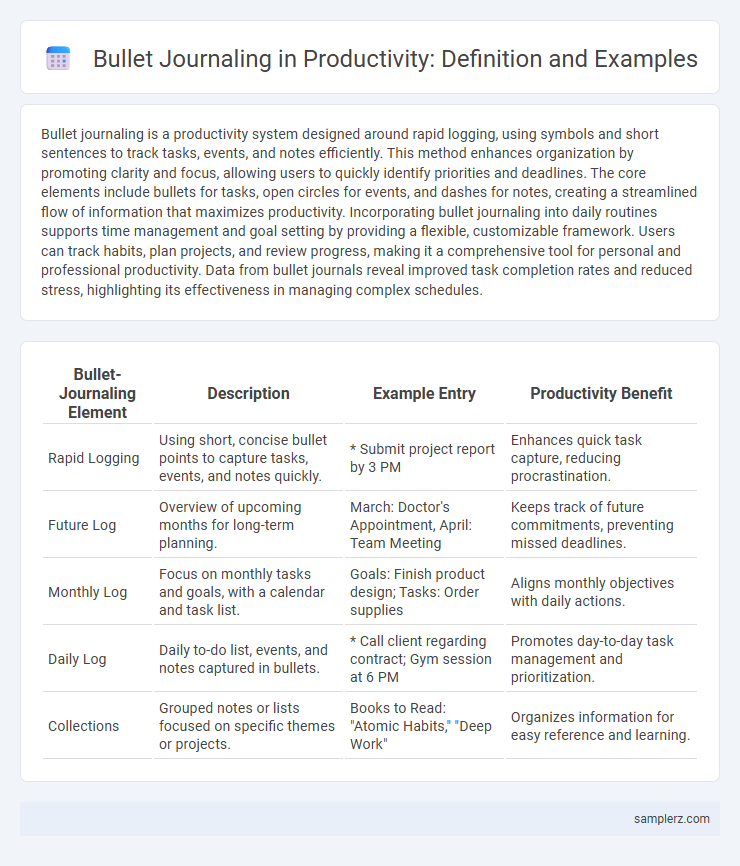Bullet journaling is a productivity system designed around rapid logging, using symbols and short sentences to track tasks, events, and notes efficiently. This method enhances organization by promoting clarity and focus, allowing users to quickly identify priorities and deadlines. The core elements include bullets for tasks, open circles for events, and dashes for notes, creating a streamlined flow of information that maximizes productivity. Incorporating bullet journaling into daily routines supports time management and goal setting by providing a flexible, customizable framework. Users can track habits, plan projects, and review progress, making it a comprehensive tool for personal and professional productivity. Data from bullet journals reveal improved task completion rates and reduced stress, highlighting its effectiveness in managing complex schedules.
Table of Comparison
| Bullet-Journaling Element | Description | Example Entry | Productivity Benefit |
|---|---|---|---|
| Rapid Logging | Using short, concise bullet points to capture tasks, events, and notes quickly. | * Submit project report by 3 PM | Enhances quick task capture, reducing procrastination. |
| Future Log | Overview of upcoming months for long-term planning. | March: Doctor's Appointment, April: Team Meeting | Keeps track of future commitments, preventing missed deadlines. |
| Monthly Log | Focus on monthly tasks and goals, with a calendar and task list. | Goals: Finish product design; Tasks: Order supplies | Aligns monthly objectives with daily actions. |
| Daily Log | Daily to-do list, events, and notes captured in bullets. | * Call client regarding contract; Gym session at 6 PM | Promotes day-to-day task management and prioritization. |
| Collections | Grouped notes or lists focused on specific themes or projects. | Books to Read: "Atomic Habits," "Deep Work" | Organizes information for easy reference and learning. |
Bullet-Journaling Basics: Understanding the System
Bullet-journaling organizes tasks, events, and notes using symbols like bullets, dashes, and circles to differentiate between to-dos, ideas, and appointments. Rapid logging enables quick capture of thoughts and tasks, enhancing productivity and minimizing mental clutter. Indexing and migration processes track priorities and progress, ensuring efficient task management and goal achievement.
Setting Up Your Bullet Journal: Key Components
Setting up your bullet journal involves creating an index, future log, monthly log, and daily log to organize tasks effectively. The index serves as a reference tool for quick access, while the future log captures long-term goals and deadlines. Monthly and daily logs break down tasks into manageable segments, promoting focused productivity and time management.
Daily Logs: Managing Your Tasks Efficiently
Daily Logs in bullet journaling streamline task management by capturing tasks, events, and notes in real-time, enhancing productivity through clear prioritization and rapid updates. By recording daily activities and to-dos, users maintain focus and track progress, reducing cognitive load. Efficient use of daily logs encourages habit formation, accountability, and structured reflection, optimizing time and clarity.
Monthly Spreads: Tracking Long-Term Goals
Monthly spreads in bullet journaling offer a structured overview for tracking long-term goals by dividing objectives into manageable milestones. Including habit trackers, priority lists, and deadline reminders within these spreads enhances accountability and progress visualization. This method supports sustained focus on productivity targets by aligning daily actions with broader ambitions.
Habit Trackers: Building Better Routines
Habit trackers in bullet journaling serve as powerful tools for monitoring daily behaviors, enabling consistent tracking of activities like exercise, hydration, and sleep quality to reinforce positive habits. By visually mapping progress, habit trackers enhance awareness and motivation, increasing the likelihood of habit formation and maintenance. This structured approach aligns with productivity goals by fostering discipline and accountability in routine-building efforts.
Rapid Logging: Capturing Ideas on the Fly
Rapid Logging in bullet-journaling enables quick and efficient capture of ideas through short, concise bullet points, symbols, and signifiers. This method enhances productivity by minimizing time spent recording thoughts while ensuring important tasks and notes are organized for easy reference. Using rapid logging promotes real-time idea tracking, helping maintain focus and streamline daily workflows.
Custom Collections: Personalizing Your Productivity
Custom collections in bullet journaling enhance productivity by allowing users to tailor their notebooks to specific needs such as habit tracking, goal setting, or project management. Creating personalized sections helps organize information efficiently, making it easier to prioritize tasks and monitor progress. This targeted approach supports sustained motivation and clarity in daily workflows.
Using Signifiers: Prioritizing with Symbols
Using signifiers in bullet journaling enhances productivity by visually prioritizing tasks with symbols such as asterisks for high importance or exclamation points for urgent items. These symbols create a clear hierarchy, allowing quick identification and focus on critical tasks amidst numerous entries. Incorporating custom signifiers tailored to personal workflows further streamlines task management and boosts efficiency.
Migration: Reviewing and Updating Your Notes
Bullet journaling enhances productivity by enabling efficient migration, where users review tasks and notes to transfer incomplete items to new logs. This process ensures prioritization of current goals and eliminates outdated information, maintaining a streamlined and focused system. Regular migration in bullet journaling fosters clarity, reduces clutter, and supports continuous progress tracking.
Real-World Examples: Bullet-Journaling Success Stories
Bullet journaling transformed Ryder Carroll's productivity by integrating task management, goal tracking, and reflections into one adaptable system that boosts focus and reduces overwhelm. Companies like Google encourage employee bullet journaling to enhance project organization and creativity, leading to measurable increases in innovation output. Real-world users report time savings of up to 30% and improved mental clarity through consistent use of symbols and rapid logging techniques in their bullet journals.

example of bullet-journaling in note Infographic
 samplerz.com
samplerz.com